| Pages:
1
..
24
25
26
27
28
..
60 |
Rogeryermaw
National Hazard
   
Posts: 656
Registered: 18-8-2010
Member Is Offline
Mood: No Mood
|
|
Quote: Originally posted by Strepta  | @Rogeryermaw:
Roger, you stated earlier that the NaCl reduced the "burn time" in your furnace by about half. How did you determine that the reaction was complete?
Are you listening for the gas bubbles in the receiver? |
yes that and the escape of vapors from the collector. you know, i haven't show this yet but i have run the reaction at night as well and, as far as
using the vapor as a guide, as i mentioned in the video about the lid notched to fit the pipe coming out of the furnace, if you don't bury it
completely, you can see the bluish, greenish, you know i'm not sure how i would describe the color, glow of a small amount of P4 vapor escaping around
the pipe...perhaps if i can devise a way to control this it will increase yield.
|
|
|
peach
Bon Vivant
    
Posts: 1428
Registered: 14-11-2008
Member Is Offline
Mood: No Mood
|
|
Don't stress it roger, it's VERY easy to make mistakes with the numbers.
I wouldn't feel down about the yield either, I'm sure it'll pick up with a bit more R&D. I'll try to get involved.
|
|
|
Rogeryermaw
National Hazard
   
Posts: 656
Registered: 18-8-2010
Member Is Offline
Mood: No Mood
|
|
aww hell i'm not down at all! the fact that it works at all is worth a lot as far as i'm concerned. i've been watching your videos quite a bit and
your work is impressive to say the least!
|
|
|
blogfast25
International Hazard
    
Posts: 10562
Registered: 3-2-2008
Location: Neverland
Member Is Offline
Mood: No Mood
|
|
Forget the hexas for a minute, take 101.961 as the MW for NaPO3 and 30.97 as the atomic weight of P.
Yield = Pout / Pin x 100%
Pout = weight P (g)
Pin = weight NaPO3 (g) / 101.961 x 30.97
Yield = 101.961 / 30.97 x (weight P / weight NaPO3) x 100
= 329 x (weight P / weight NaPO3) (in %)
... which works out as 13%.
That's quite disappointing of course. I wonder why the yield is so low...
|
|
|
Rogeryermaw
National Hazard
   
Posts: 656
Registered: 18-8-2010
Member Is Offline
Mood: No Mood
|
|
it was the whole hexa thing that brought about my miscalculation. if you take that 13% and multiply it by 6 you get my original estimate of 78%. ya
the yield is low i agree. the process, i'm sure, needs streamlining. perhaps there is a better flux i can use or a tweaking of the amounts of this or
that reactant. the process is in its infancy and i'm sure if we put our collective experience and innovation into it we can get it better. even still,
with how cheap the reactants in this synthesis are, i'm thrilled to get phosphorus at all! may not be ideal but it's better than the P4 i had
before(none).
a few things that come to mind are the reactor for one...how much may still be trapped inside? the collection method is losing quite a bit to
atmosphere as i stated already since i am counting on vapors condensing in such a short distance and with minimal exposure to the water since we
feared the possibility of a steam explosion. there are certainly many factors to be improved. given time and trials the numbers can certainly be
improved upon.
i should have weighed the product from the last run. it is my belief that my percentage of theoretical would be closer to 19-20%
|
|
|
blogfast25
International Hazard
    
Posts: 10562
Registered: 3-2-2008
Location: Neverland
Member Is Offline
Mood: No Mood
|
|
Quote: Originally posted by Rogeryermaw  |
a few things that come to mind are the reactor for one...how much may still be trapped inside? the collection method is losing quite a bit to
atmosphere as i stated already since i am counting on vapors condensing in such a short distance and with minimal exposure to the water since we
feared the possibility of a steam explosion. there are certainly many factors to be improved. given time and trials the numbers can certainly be
improved upon.
i should have weighed the product from the last run. it is my belief that my percentage of theoretical would be closer to 19-20%
|
I think there must be considerable amounts of reaction product phosphorus still locked into the slag. Not sure how one would would go about proving
that though...
If there's unreacted NaPO3 in the slag, grinding and leaching with water should show that up...
Of course it's impossible to gauge how much P you're losing at the collection point...
|
|
|
peach
Bon Vivant
    
Posts: 1428
Registered: 14-11-2008
Member Is Offline
Mood: No Mood
|
|
I agree with bloggerman, and was about to suggest that before reading his reply. If the bubbling stops, it signals the end; theoretically. But there's
a good chance some of it is still hiding in the actual melt it's self. Quite a lot from those numbers.
On the next run, I'd look for phosphorus trying to escape the collector; test for it, don't sniff  . If any significant amount is found, you could try cooling the collector, like in the metalresearcher sodium thread. . If any significant amount is found, you could try cooling the collector, like in the metalresearcher sodium thread.
If no real value is escaping, it's got to be in the melt still. Have you tried roasting for any period of time after the bubbling stops? That's a bit
of a weak suggestion.
It may need more heat for a higher temperature, or something to push it to the collector, the same way a Dean-Stark needs the water gone to drive it
through to the right side of the equation; this may need more heat to drive it out of the melt and to the collector (?it's absorbing in the melt?
Hydrogen chloride absorbs nicely in water to hydrochloric, but then comes back out at room temperature for strong acid and all of it is out once the
water is gone or the temperature is raised).
From all the gas work I've done, I do know that you have to massively bias the amount of gas you're using over the theoretical for it to absorb
properly. They just don't function like liquid / liquid reactions in terms of the theory, unless they're run INCREDIBLY slow and gently, with frits
and such. Maybe you could add a frit of metal sponge to the end of the pipe. I know where you can get some aluminium sponge for free. But, as I've
learnt with all my gas wash bottles, that's not always a good thing. As they tend to clog. And clogging, mid anhydrous, pressure producing work
involving the reactive gases is not good in anyway!
Before even trying the flame method, I'm already wondering about using electrodes and arc welders.
Again, forget worrying about 13%. A total organic synthesis can yield 1% and below after a huge amount of work by genuinely the best chemists around.
It doesn't matter when the things going in and process are cheaper than some beer. And when it's only the first few tries.
{EDIT} I just had A THOUGHT! When I'm trying to truly capture a nasty gas from a reaction, like hydrogen chloride, I don't just use
water. I use a base in the wash to salt the gas out; as the acidic gas will neutralize with the base. It works so well I can't smell / feel anything,
even with my nose against the exhaust. If absorption was a problem at the collector, maybe you could use something similar. Make it faaaar more
favourable, energetically, for it to stay in that collector, but in a form that can be easily extracted afterwards. This same trick works for
horrendously toxic materials, and it's how they do things industrially where fume hoods don't mean anything. {that EDIT tag seriously annoys
me, yeah one, fine. But having to constantly edit an edit tag for missed spaces and spellings....}
To liven things up, here's a funny video for all you welding and fire fans (me included);
<object width="660" height="525"><param name="movie"
value="http://www.youtube.com/v/G6Uxh-xtU-g?fs=1&hl=en_GB&color1=0x5d1719&color2=0xcd311b&border=1"></param>&
lt;param name="allowFullScreen" value="true"></param><param name="allowscriptaccess" value="always"></param><embed
src="http://www.youtube.com/v/G6Uxh-xtU-g?fs=1&hl=en_GB&color1=0x5d1719&color2=0xcd311b&border=1"
type="application/x-shockwave-flash" allowscriptaccess="always" allowfullscreen="true" width="660" height="525"></embed></object>
You think that's enough juice? It's enough that they have to talk with the grid before building and starting one of these up. It's a good 1% of what
the fission stations can actually output, flickering on and off as the arc makes and breaks. Can't get enough of the sparks, fire and grid hum. I like
the way they've got some pop music on in the quiet control room, watching it.
<object width="660" height="525"><param name="movie"
value="http://www.youtube.com/v/ijWwfcw0FOo?fs=1&hl=en_GB&color1=0x5d1719&color2=0xcd311b&border=1"></param>&
lt;param name="allowFullScreen" value="true"></param><param name="allowscriptaccess" value="always"></param><embed
src="http://www.youtube.com/v/ijWwfcw0FOo?fs=1&hl=en_GB&color1=0x5d1719&color2=0xcd311b&border=1"
type="application/x-shockwave-flash" allowscriptaccess="always" allowfullscreen="true" width="660" height="525"></embed></object>
[Edited on 30-9-2010 by peach]
|
|
|
Rogeryermaw
National Hazard
   
Posts: 656
Registered: 18-8-2010
Member Is Offline
Mood: No Mood
|
|
Quote: Originally posted by peach  |
On the next run, I'd look for phosphorus trying to escape the collector. If any significant amount is found, you could try cooling the collector, like
in the metalresearcher sodium thread.
[Edited on 30-9-2010 by peach] |
my thought was to eliminate things one by one. as i said before, there is definitely some loss to atmosphere. visualize this: at the end of the pipe
the P(g) is at least 280 Celsius(b.p. of P)when it has to condense to liquid in less than an inch depth of water(as deep as i have submerged the pipe
yet. will try deeper and with cooler water). to cool such hot gas to 44Celcius(m.p. of P) is going to be quite less than 100% efficient at this depth.
my thinking is to dig the collector deeper and use a longer down pipe with cooler water. i'll give this a try and we can go from there. when i do run
it i will be sure to weigh my product and post the analysis of any improvement in yield.
|
|
|
peach
Bon Vivant
    
Posts: 1428
Registered: 14-11-2008
Member Is Offline
Mood: No Mood
|
|
Yep, dead on, longer, taller collector and cool it some way if you can, keeping the condenser cold and the pipe warm.
The step from 280 to 44 is a big one to make to achieve a gas -> liquid / solid theoretical yield! Before it ever collects, it has to loose a lot
of heat, quickly. If the collector is hot (warm), it'll try to get through. Same with buchi's. Boiling off a volatile, connect them to a rotary and
hey presto! You have solvent in the pump, even with a dry ice finger in the way. Doesn't have long enough or a big enough gradient to cool through.
Heat capacities are something worth wiki'ing here. Some things at 1000C cool to 0C with next to no effort. Others, like water, need to dump a huge
amount of energy in the process.
Those state changes soak up / release energy, orders of magnitude more than liquid / liquid chemistry.
Theoretically, I should be able to condense numerous volatiles under vacuum with ice in my condenser loop. In practice, it's a harder than that.
[Edited on 30-9-2010 by peach]
|
|
|
aax
Harmless

Posts: 13
Registered: 23-9-2010
Member Is Offline
Mood: No Mood
|
|
The bad guys don't need your phosphorus... I don't need you to post a video. A video would make it easier but it is not nessesary.
|
|
|
Rogeryermaw
National Hazard
   
Posts: 656
Registered: 18-8-2010
Member Is Offline
Mood: No Mood
|
|
good then slag off ya smart anus
produce a better attitude and make some contributions here and i will be much more willing to share. phosphorus is poisonous and lethal in less than
50 milligram quantities. it could kill you with the tiny bit stuck under your fingernail from handling it without protection. you haven't shown anyone
here that you have the equipment or safety consciousness to handle chemicals with high toxicity.
and no one said the "bad guys" need it. they have their own means but you are obviously fishing for something...
[Edited on 30-9-2010 by Rogeryermaw]
|
|
|
Strepta
Harmless

Posts: 44
Registered: 6-5-2004
Member Is Offline
Mood: No Mood
|
|
Roger-- an important first step is to determine the mass of the post reaction residuals and compare this with the mass of your initial charge. This
difference vs what you actually collect will give you an indication of your collection efficiency. This is most easily done by weighing the entire
apparatus pre and post-reaction. You need to do this with sufficient resolution to be able to "see" differences of a gram or two at the levels you are
experimenting with. Can you do that with your reactor and pipe or will it be too massive for your scale? If it is too massive, you will need to
carefully clean out and weigh all post reaction slag and unreacted chems and compare with the initial charge-- this is more of a PITA but ultimately
helpful in determining loss mechanisms.
|
|
|
Rogeryermaw
National Hazard
   
Posts: 656
Registered: 18-8-2010
Member Is Offline
Mood: No Mood
|
|
ya my scale only does 600 grams unfortunately but (and you aint kiddin' pain i.t.a.) weighing the reaction mass is possible with the can type i used.
it can be cut and peeled off the mass of slag without too much hassle. when a heavier vessel is used it may prove more challenging. i think another
run in more controlled circumstances is called for with more stringent data records.
|
|
|
blogfast25
International Hazard
    
Posts: 10562
Registered: 3-2-2008
Location: Neverland
Member Is Offline
Mood: No Mood
|
|
Quote: Originally posted by Rogeryermaw  | | it can be cut and peeled off the mass of slag without too much hassle. when a heavier vessel is used it may prove more challenging. i think another
run in more controlled circumstances is called for with more stringent data records. |
Have you actually had a close look at the slag inside the can? You might actually find quite some P near the exhaust... Just a thought...
|
|
|
Rogeryermaw
National Hazard
   
Posts: 656
Registered: 18-8-2010
Member Is Offline
Mood: No Mood
|
|
yes sir i have. i reuse the 3/4 and 1/2 inch piping on each reactor. there is little if anything to get from it. however under the conditions i've
been using it would likely burn away trying to recover it. from my observations the bulk of the P is still in a gaseous state until it hits the water
at which point some is recovered and some is lost, the ratio of which is still a mystery to me. it is my (quite unconfirmed) opinion that there may
still be some in the melt, some of the chemicals are not reacting and there are losses to atmosphere. keep those thoughts coming though because they
are what have been pushing me in the right direction.
it also occurs to me that some of the reaction may not be as straightforward as i have been assuming. there may be significant losses to the formation
of metal-phosphides as part of the slag. that, to me, would be an acceptable loss since it is the use of a reactive metal that has brought the whole
concept of phosphorus production within the reach of home experimenters. i wonder if using the excess aluminum is contributing to this...
upon further study this seems very likely since AlP is sold as rodenticide under trade names: Celphos, Fumitoxin, Phostoxin, and Quick Phos which are
produced by igniting a mixture of phosphorus and aluminum.
[Edited on 1-10-2010 by Rogeryermaw]
[Edited on 1-10-2010 by Rogeryermaw]
[Edited on 1-10-2010 by Rogeryermaw]
|
|
|
blogfast25
International Hazard
    
Posts: 10562
Registered: 3-2-2008
Location: Neverland
Member Is Offline
Mood: No Mood
|
|
Quote: Originally posted by Rogeryermaw  |
it also occurs to me that some of the reaction may not be as straightforward as i have been assuming. there may be significant losses to the formation
of metal-phosphides as part of the slag. that, to me, would be an acceptable loss since it is the use of a reactive metal that has brought the whole
concept of phosphorus production within the reach of home experimenters. i wonder if using the excess aluminum is contributing to this...
upon further study this seems very likely since AlP is sold as rodenticide under trade names: Celphos, Fumitoxin, Phostoxin, and Quick Phos which are
produced by igniting a mixture of phosphorus and aluminum.
|
It's possible than AlP is formed, I didn't think of that. Whether or not AlP is formed in those conditions depends largely on the Heat of Formation of
the AlP, because that's what affects the equilibria that I briefly described above.
But using an excess of Al would certainly favour it's formation. P is well known for its propensity to form compounds by direct union with other
elements. So perhaps it's better to 'starve' the mixture of Al, i.e. 90% of stoichio, rather than 110%.
I doubt that even 100 % conversion of the excess Al to AlP would account for all the 'missing' P...
[Edited on 1-10-2010 by blogfast25]
|
|
|
Rogeryermaw
National Hazard
   
Posts: 656
Registered: 18-8-2010
Member Is Offline
Mood: No Mood
|
|
it also depends on how the reaction proceeds too. does all the P evolve then react with excess Al or do these reactions proceed simultaneously. in the
first instance a stoich amount or less would be favorable. in the second instance it seems that both P and AlP would be formed regardless of quantity
of Al. would be nice to have a way to analyze the slag but i don't think i want to toss it in water and see if it kills me(since metal phosphides
release phosphine when wet). any other ideas for analysis? perhaps i could catch a mouse and put it in an aquarium then powder some of the slag, place
it in the aquarium and wet it then cover the top(outside of course). homemade pesticide anyone? 
you animal rights guys can piss off before posting. i live in the country and mice are a problem as it is.
[Edited on 1-10-2010 by Rogeryermaw]
|
|
|
peach
Bon Vivant
    
Posts: 1428
Registered: 14-11-2008
Member Is Offline
Mood: No Mood
|
|
React it with water under a lid, pipe off any evolving gas, run it through a blow torch flame in another lid capable vessel and weigh for solid
P.pentoxide? Not super safe, but seems the easiest. And you get some free garden fertilizer out of it.
Danger Roger, Danger!
Given the amount of what could be hiding in that melt, I would HIGHLY recommend you chip off a sample lump, weigh that, then do the
test on a small chunk of it. As opposed to doing the whole melt. If the melt isn't homogeneous (e.g. if there's a distinct layer or clumping of
something that looks different to the rest), you need to account for that.
A possible embodiment based on what you have / suggested. Smash up the melt lump sample, do the reaction in a pipe nipple etc, tube it off to said
aquarium with a piece of glass over the top and the light blowtorch inside (you want the tube exiting right into the flame if possible, peak of the
blue cone). The p.pent should coat the glass. Scrape it back off with a razor blade when you're sure it's finished, resist urge to do whole melt so
you can measure it on the kitchen scales, buy $10, 0.01g, Made In China, pocket scale from eBay (checked 'em, they're less than 1% off a £3k, 0.1mg
balance), weigh.
This is where googlemapping our rough locations and meeting up would be kick ass. If we were near by each other, I have all the gas handling glass and
the balance. And I could find a use for some of that phosphine for doping my at home semiconductor attempts.
As if chemists didn't have enough problems, now PETA's gonna start bricking our windows and then running away (if they can get the energy together) to
kill some more mycoprotein producers and vegetables.
PETA wrote to Timothy McVeigh whilst he was on death row, appealing for him to be fed a vegan diet to end the killing. Here's his reply (already
posted it once, but love it), which I've not heard many others suggest and I couldn't put it any better myself;
| Quote: | | Truth is, I understand your cause - I've seen slaughter houses myself - but I still believe in reasonable taking and eating of game (as an outdoorsman
and hunter)... I cannot sustain a prolonged intellectual debate on the subject as my time is short, but I'd suggest hitting Ted Kaczynski up for his
opinions on the subject. [...] Where do you draw the line and what standard is used to define that line? Those that are in it for the health benefits
accept poultry and fish as edible. Where do those opposed to suffering stand? (Ever see a fish struggling out of water?) What about grubs/worms/etc.?
And finally, plants are alive too, they react to stimuli (including pain); have circulation systems, etc. So how about them? |
[Edited on 1-10-2010 by peach]
|
|
|
Rogeryermaw
National Hazard
   
Posts: 656
Registered: 18-8-2010
Member Is Offline
Mood: No Mood
|
|
as unpopular as it may be, i will grub the hell out of a steak. i will eat any meat just about(except tube steak)and veggies are fair game too. the
activists piss me off. when i was working in colorado (the aforementioned job i had doing security and networking installations in military facilities
took me all over the country from florida to montana, from michigan to hawaii and several points in between. mentioned this to you peach as the time i
was in colorado was the last time i actually visited with that good friend of mine) the guys that liked to ride the trails always told us horror
stories about the "green gangs". they hated the guys who rode the trails saying they were hurting the environment so they would "spike" the trails to
disable the 4 wheelers. however what they accomplished was attempted murder. people would fall off their machines and be badly injured. said machines
would fall off cliff sides being destroyed leaking fuel and oil into the environment they were "saving". mindless freaks! i'm not saying i support
wrecking the environment, i dispose of anything dangerous in legal manner but the green activists go too far. i'm american so let them try to put a
brick in my window. i got something for 'em! if my dogs haven't killed them before they get close, here where i live, trespassers get shot.
i think this is a fine idea about weighing the P2O5 as a combustion product. weigh the mass i'm testing, weigh the water used, weigh the mass after
testing and and P2O5 that may form should give us an idea where all the rest of the P is going.
got a link for the seller of that scale? love the mcveigh quote...guess were going to have to live on fungus!
|
|
|
blogfast25
International Hazard
    
Posts: 10562
Registered: 3-2-2008
Location: Neverland
Member Is Offline
Mood: No Mood
|
|
When I ran my 10 g (or so) NaPO3/Al/SiO2 reaction (stoichiometric ratio) in a 1 fl. oz steel tumbler (simply by heating it to red heat in open air), I
obtained a typically black, foamy mass of slag with a slightly odd smell but definitely no phosphines developed. But during the reaction I clearly saw
very visible green-yellow phosphorescence from liquid P, until the P caught fire and nice little yellow jets of burning P left white P2O5 smoke
behind. I remember switching the heat off but it just kept going for a while... Strepta with his ceramic tube reaction didn't report any problems with
phosphine from the slag either. I think we may be worrying a tad too much about AlP and phosphines...
Edit: similar reactions with quartz tubes were conducted both by Strepta and Magpie...
The reactions probably do run 'simultaneously' here, and the dissociation of P2O5 ---> 1/ P4 + 5/2 O2 is probably the rate-determining step, as it
takes a lot of heat to get some dissociation going and thus that reaction is probably the slowest of them all.
The formed O2 would be scavenged by 2 Al + 3O2 ---> Al2O3 superfast because of the massive Heat of Formation of Al2O3.
[Edited on 2-10-2010 by blogfast25]
|
|
|
peach
Bon Vivant
    
Posts: 1428
Registered: 14-11-2008
Member Is Offline
Mood: No Mood
|
|
These are the exact ones I have;
ONE!
TWO!
THREE!
HA, AH, AH, AH!

If you go on eBay and search for "0.01g" / "jewellery" / "jewelery" / "scales" a whole ton of them will turn up. A lot of them are probably from the
same factory with the same circuit and weigh bridge in them. Those ones I bought are some of the cheapest on there.
You'll need to get a set to weigh the 10g results and definitely the oxide from a sample of the melt. It's not the RESOLUTION that matters, you don't
need to know the 10g numbers to 0.00000001g, but the ACCURACY. Those digital kitchen scales could easily be off by a gram or two at 10g (see the
graphs at the end).
Maybe I should buy a whole bunch of these things, produce curves for them on the 0.1mg balance and resell them so people can get cheap, accurate
balances with known errors.
You shouldn't need to weigh the water, just the sample from the melt and the resulting oxide. I'm off to watch the UK fireworks championship, day two,
so I can't find the numbers right now, but it could really do with working out a safe / measurable sample to use from the melt, assuming it's all
hiding as AlP and will go to phosphine. E.g. not the entire melt, but enough that the oxide will show up as a solid number on one of those cheap
scales.
I remembering reading, quite randomly whilst wandering around the library in my teens, a book on military warfare. Where they discuss how chemical
weapons need their lethal doses multiply up by tens of thousands of times, or more, when dispersed into the air, because they'll dilute down so much
before they ever touch someone. The way to test for the AlP safely would be to use a smaller sample and do it outside, downwind, as you're aware.
Graphs I will post up with more explanations at some point; click to get the full version (don't want to make the forum look all spazzed out
posting them full size here)
This is my Made In China 0.01g scale (in red) and the digital 1g kitchen scale. The scales on the left and right are not the same.
Notice that the;
a.) 'drug dealer' scale is almost always permanently biased to a give a positive result, don't tell them that 
b.) error doesn't massively grow or shrink
c.) pattern of error isn't very predictable
d.) 1g kitchen scale is HORRIBLY inaccurate at low numbers
e.) error DOES shrink for the kitchen scales, considerably, and conveniently, as the 0.01g scale cuts off (you can get 100g versions of these 0.01g
things, perfect combination according to this graph)
f.) there is quite clearly a periodic swing from positive to negative for the kitchen scales once the mass being weighed goes over 50 - 100g
Scale comparison
Here I'm measuring the mass of all the 20p's, I think, from a big jar of change. I've done it for 1, 2, 10, and 5s as well. Notice that the;
a.) mass of the coins 'on the street' seems biased towards being more than their minted mass. Meaning gunk is building up on their surface quicker
than they're wearing down (oxides, salts, greases etc)
b.) it's swinging in a periodic way, up and down, every few years and the coins that are decades old have about the same error as those that are new.
So the main error in mass is controlled by the minting accuracy, not handling. The sine wave is the mint tweaking the presses and changing the dies
for the coins. Importantly, it's periodic and swinging by roughly the same amplitude, positive and negative.
Errors in coins mass
If I take a stack of ten or twenty coins, randomly out of the jar, the errors begin canceling each other. When I sum up all the errors, this
happens...
The % to which I can predict the mass of the stack of coins drops waaaaay down; multiple readings and error canceling.
Some of the cells on here look a bit wonky, hence me not posting it as a final thing yet, I need to finish it off really.
Important numbers
If anyone in the US would like to send me a jar full of low value coins, I can do the same for the US. I'll need 10 - 30 of each value for it to give
a good result. I also don't know if they'd vary much from state to state, or if it's all coming from roughly the same mint or at least others
controlled to the same standards as each other. I expect it is, or coin operated machines wouldn't work.
What's good about using low value coins is the mint controls the main error, tightly. Everyone has access to it, even tramps. Best of all, the
canceling works better the less effort you put into sorting the coins, it works best with an entirely random selection of dirty /
shiny, uncleaned coins and from various, random dates.
[Edited on 2-10-2010 by peach]
|
|
|
Rogeryermaw
National Hazard
   
Posts: 656
Registered: 18-8-2010
Member Is Offline
Mood: No Mood
|
|
i will get to the more important numbers and testing soon but here is some preliminary data.
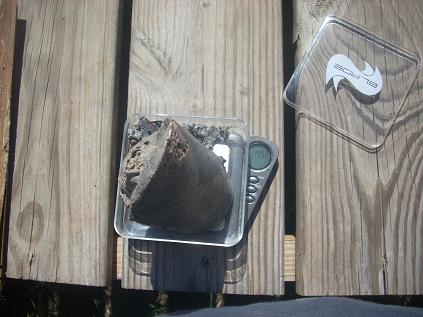
the initial weight of the reactants was about 217g and post reaction almost 200g give or take (scale accuracy)
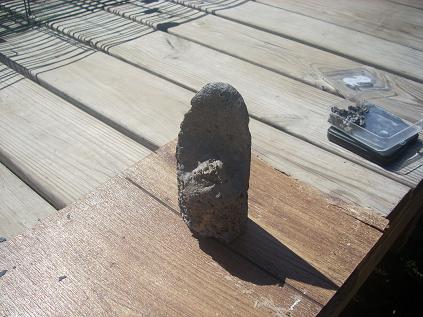
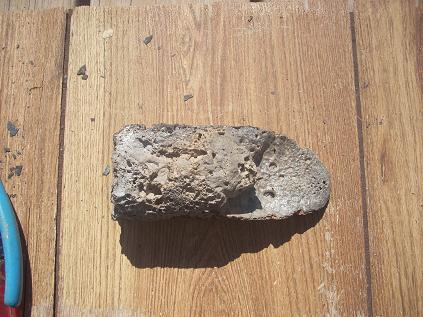
mass as removed from can (minor losses due to the brittle nature of the slag)
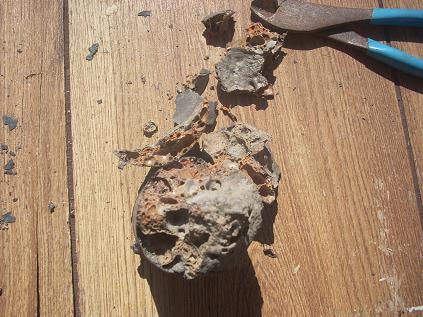
appearance of the inside. note the gas pockets. smelled terribly of phosphorus when broken open(wasn't trying to sniff it but couldn't help catching
small whiff as it was very strong.
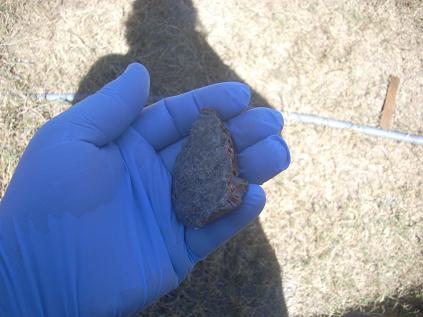 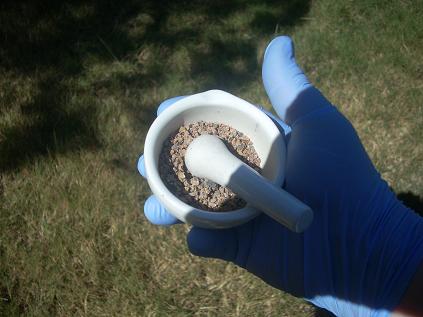
prepping a small piece to test for formation of PH3.
sorry i did not snap the process as i was nervous enough about TRYING to produce something deadly. was hard to tell for sure but i wet the ground mass
in a pickle jar and placed a propane torch over the top. the water appeared to cloud during this but i'm not sure if that indicates absorption of
P2O5. i did, however note greenish yellow deposits that fit the physical description of AlP.
based on the weights the reaction mass lost 17(ish) grams leaving 10-12 grams to account for after subtracting the estimated weight of phosphorus
collected.
[Edited on 2-10-2010 by Rogeryermaw]
|
|
|
blogfast25
International Hazard
    
Posts: 10562
Registered: 3-2-2008
Location: Neverland
Member Is Offline
Mood: No Mood
|
|
Good work!
You could repeat that small test by means of some muriatic acid (HCl) instead of water, that would be definite proof... (AlP +3 HCl ---> AlCl3 +
PH3). AlP may be more resistant to H2O than we might think...
Bear in mind though that although AlP will have a considerable Heat of Reaction (it can indeed be synthesised by direct union of the two elements),
the HoF of Al2O3 is likely to be much higher, thus enormously favouring the formation of the Al oxide over formation of the phosphide, at least in
near-stoichiometrical conditions. In the presence of large excesses of Al, formation of AlP would almost certainly occur. A formulational error could
thus have dire unintended consequences!
We shouldn't exclude unreacted NaPO3 being present in the slag either: in a melt like that, dropping concentrations of one of the reagents may cause
reactions speed to drop quickly and thus yield to be very incomplete...
[Edited on 2-10-2010 by blogfast25]
[Edited on 2-10-2010 by blogfast25]
|
|
|
Strepta
Harmless

Posts: 44
Registered: 6-5-2004
Member Is Offline
Mood: No Mood
|
|
There will always be some traces of phosphine, evidenced as gas bursting into flame as it surfaces the water in the receiver. This is presumably due
to an inability to completely de-hydrate the calgon. I performed my experiments 2-3 years ago (indoors) using my fume hood. Following the reaction I
disassembled the apparatus underwater (after careful post-reaction weighing) and don't recall any evidence of a reaction between the slag and the
water. An abundance of caution is always advisable, however.
"Incorporation" of the ingredients may be a factor. Have you ever made your own black powder and compared it to a sample of XXX Goex? It's no contest.
I used pyrotechnic Al with the calgon and silica flour and whizzed everthing in a coffee grinder for 2-3 minutes.
I averaged about 50% yield (actual recovered vs theoret. available). The weighing indicated that about 70% of the theoret. P was released. Collection
efficiency was therefore about 75%, which was good enough for my purposes.
not_important suggested using an equimolar amount of boria (boron trioxide) for silica, which I tried. It actually produced a marginally higher yield
(52%) and the slag appeared to be a lesser amount. Boria begins to soften about 450C, considerably lower that pure silica.
Looking forward to your next results!
|
|
|
blogfast25
International Hazard
    
Posts: 10562
Registered: 3-2-2008
Location: Neverland
Member Is Offline
Mood: No Mood
|
|
Considering the cost differential silica - boria and the minor advantage you observed, I'm not sure that test would be worth the expense, at least not
w/o some further optimisation to the current set up...
Boria isn't easy to purchase but it can be made quite easily from borax and muriatic acid. It just adds another step to the chain...
|
|
|
| Pages:
1
..
24
25
26
27
28
..
60 |